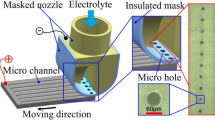Abstract
The machining quality of array flow channels directly affects the performance of solid oxide fuel cells as they are the key structures on the metallic interconnects of these cells. Electrochemical machining (ECM) is an efficient and low-cost technology for fabricating array flow channels. In the conventional ECM method, the cathode tool is usually designed to have cavity structures above the ribs to avoid collisions between the tool and workpiece. These cavities provide a passage for stray current to corrode machining fillets, causing electrolytes to flow away, and resulting in an uneven distribution of electrolyte flow velocity. To address these challenges, the authors propose a novel type of ECM cathode tool with a comb-shaped insulator. As the cathode tool is fed, the comb-shaped insulator is pressed tightly to the ribs by the spring compression device. This allows the insulator to shield the stray current and block the electrolyte shunt gap, thus enhancing the profile accuracy of the ribs and stability of the electrolyte flow field significantly. Furthermore, to verify the beneficial effect of comb-shaped insulator tools, the authors carry out simulations of the forming processes and flow field in the ECM of array flow channels. Finally, the experiments were carried out to compare 13 flow channels with lengths of 60 mm using the conventional and proposed methods. The experimental results show that the machined specimen exhibited better flatness at the top surface of the ribs and an enhanced surface quality of the channels’ bottom when the cathode tool with a comb-shaped insulator was used.























Similar content being viewed by others
Availability of data and materials
All data generated or analyzed during this study are included in this article.
Code availability
Not applicable.
References
Ellen IT, André W, Herbstritt D (2001) Materials and technologies for SOFC-components. J Eur Ceram Soc 21:1805–1811
Talic B, Molin S, Wiik K, Hendriksen PV, Lein HL (2017) Comparison of iron and copper doped manganese cobalt spinel oxides as protective coatings for solid oxide fuel cell interconnects. J Power Sources 372(31):145–156
Morales M, Roa JJ, Capdevila XG, Segarra M, Piñol S (2011) Anode-supported SOFC operated under single-chamber conditions at intermediate temperatures. J Fuel Cells 11(1):108–115
Elisa V, Ciro AR, Alex E, Joaquim C (2010) An experimental analysis of process parameters to manufacture metallic micro-channels by micro-milling. Int J Adv Manuf Technol 51:945–955
Shamoto E, Saito A (2016) A novel deep groove machining method utilizing variable-pitch end mill with feed-directional thin support. Precis Eng 2016:277–284
Gao P, Wang XB, Liang ZQ, Zhang SY, Zhou TF (2017) Effects of machining inclination angles on microgroove quality in micro ball end milling of Ti-6Al-4V. Int J Adv Manuf Technol 92:2725–2734
Hung JC, Chang DH, Chuang Y (2012) The fabrication of high-aspect-ratio micro-flow channels on metallic bipolar plates using die-sinking micro-electrical discharge machining. J Power Sources 198:158–163
Tsai MY, Fang CS, Yen MH (2018) Vibration-assisted electrical discharge machining of grooves in a titanium alloy (Ti-6A-4V). Int J Adv Manuf Technol 97(1-4):297–304
Xin F, Ma T, Chen Y, Wang Q (2019) Study on chemical spray etching of stainless steel for printed circuit heat exchanger channels. Nucl Eng Des 341:91–99
Xu ZY, Wang YD (2019) Electrochemical machining of complex components of aero-engines: Developments, trends, and technological advances. Chin J Aeronaut 34(2):28–53
Ghoshal B, Bhattacharyya B (2015) Vibration assisted electrochemical micromachining of high aspect ratio micro features. Precis Eng 42:231–241
Lee YM, Lee SJ, Lee CY, Chang DY (2009) The multiphysics analysis of the metallic bipolar plate by the electrochemical micro-machining fabrication process. J Power Sources 193:227–232
Rathod V, Doloi B, Bhattacharyya B (2015) Influence of electrochemical micromachining parameters during generation of microgrooves. Int J Adv Manuf Technol 76(1-4):51–60
Chen XL, Dong BY, Fan GC, Zhang CY, Liu JW, Zhang YJ, Guo ZN (2019) Investigation on modified jet electrochemical machining of micro-channel. Int J Adv Manuf Technol 104:4433–4443
Liu GX, Zhang YJ, Deng Y, Wei HY, Zhou C, Liu JW, Luo HP (2017) The tool design and experiments on pulse electrochemical machining of micro channel arrays on metallic bipolar plate using multifunctional cathode. Int J Adv Manuf Technol 89:407–416
Jiang XC, Liu J, Qu NS (2018) Electrochemical machining multiple slots of bipolar plates with tool vibration. Int J Electrochem Sci 13(6):5552–5564
Funding
This work is supported by the Joint Funds of Natural Science Foundation of China and Guangdong Province (Grant U1601201) and the Natural Science Foundation of Jiangsu Province (Grant BK20192007).
Author information
Authors and Affiliations
Contributions
Jia Liu conceived of the study, designed the study, and collected the data. All authors analyzed the data and were involved in writing the manuscript.
Corresponding author
Ethics declarations
Ethical approval
The article follows the guidelines of the Committee on Publication Ethics (COPE) and involves no studies on human or animal subjects.
Consent to participate
Not applicable.
Consent to publish
Not applicable.
Competing interests
The authors declare no competing interests.
Additional information
Publisher’s note
Springer Nature remains neutral with regard to jurisdictional claims in published maps and institutional affiliations.
Rights and permissions
About this article
Cite this article
Liu, J., Liu, Y., Jiang, X. et al. Electrochemical machining of array flow channels using cathode tool with comb-shaped insulator. Int J Adv Manuf Technol 116, 2031–2043 (2021). https://doi.org/10.1007/s00170-021-07484-7
Received:
Accepted:
Published:
Issue Date:
DOI: https://doi.org/10.1007/s00170-021-07484-7



